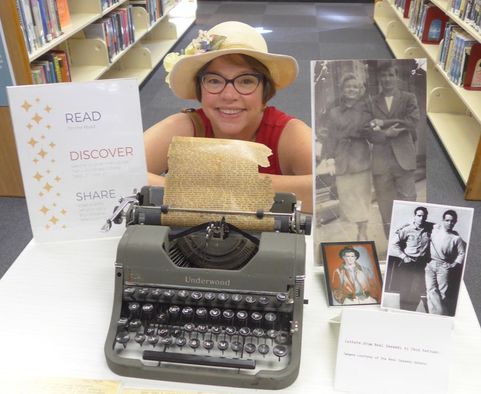|
Jack Kerouak’s scroll manuscript for On the Road—or at least the first 40 feet of it--is on display a library near where I live. Kerouac typed fast and hated stopping to change paper, so he taped together a roll of paper 120 feet long and in three weeks typed the first draft of On the Road. I saw the scroll before, years ago, in San Francisco, and what impressed me then was how long it was. The narrow case seemed to go on forever. This time when I saw it, I was prepared for the long narrow case, so I took a closer look at the manuscript itself. It was yellowed and tattered and typed single space. If you want to see an image of the scroll’s opening, NPR has a nice one here: https://www.npr.org/programs/atc/features/2005/feb/kerouac/scroll.html Near the start of the scroll, the curators propped open the finished book to the novel’s beginning, making comparisons easy. Leaning over to read the scroll, I got my first jolt. The draft opening mentions “Neal” not the published version’s “Dean.” I don’t typically write autobiographical fiction (though of course all fiction has some autobiography in it), so I had assumed that Kerouac had meant from the beginning to fictionalize his journey. But here he was, straight up using Neal Cassidy’s real name. Let me just say now that I have never been in love with On the Road. I think it’s messy and half-thought-out in many places, maybe because Kerouac included too much unshaped real life. I read the book in college (I still have my paperback copy, almost as yellowed as the scroll, labeled “25th Anniversary Edition”). In that class, another student described how he’d read the book when he was 17, and that it had inspired him to travel, and was in fact one reason he was studying at Berkeley—he’d grown up in the East and wanted to go somewhere new. I, however, did not find the book so inspiring. Maybe at 20 I was already too old for it. The book seemed naïve. I remember thinking: “They go to Mexico, and smoke a big joint and go to a brothel? That’s it? That’s the ultimate vision of freedom on the road?” Also, the dismissiveness towards women in the book turned me off. Kerouac seemed mostly incapable of imagining that women had inner lives—they existed only to serve or thwart the men’s needs. And yet, the book has its lyrical passages, its unusual and well-chosen adjectives and verbs, it’s jazzy rhythm. The book contains a lot of dreck, but it also contains moments of startling beauty. So, when I look at the scroll, I see not a relic of a perfect book, but a testament to Kerouac’s sheer determination to write, to put his vision into words. He found a way to get his draft out, and that’s a huge task for any writer. Then he edited, removing words, removing paragraphs, rewriting. The scroll is not a symbol of unconstrained creativity, but of writing process working. It took me many tries to get beyond the first fifty pages of a book. When described my problem to one instructor in my MFA program, he suggested writing on smaller paper, stationery sized. He found it gave him less pressure—it didn’t seem like so much empty space to fill up. I was horrified. I hate writing on small paper because the size feel like it's hemming in my thoughts. We all have to discover our own way to get moving, to get the book out of our heads. The scroll is Kerouac’s triumph over the blank page, an inspiring achievement. Bonus: I love this clip from the Steve Allen show where Kerouac reads from On the Road while Steve plays jazz piano. Allen interviews Kerouac first—the reading starts about halfway in. For me, this kind of prose is the best part of On the Road: https://www.youtube.com/watch?v=3LLpNKo09Xk
0 Comments
Your comment will be posted after it is approved.
Leave a Reply. |
Author
Ann Hillesland writes fiction and essays. Her work has appeared in many literary journals, including Fourth Genre, Bayou, The Laurel Review, and Sou’wester. Categories
All
Archives
February 2024
© Ann Hillesland 2015-2017. Unauthorized use and/or duplication of this material without express and written permission from this site’s author is strictly prohibited. Excerpts and links may be used, provided that full and clear credit is given to Ann Hillesland with specific direction to the original content.
|


 RSS Feed
RSS Feed